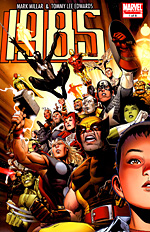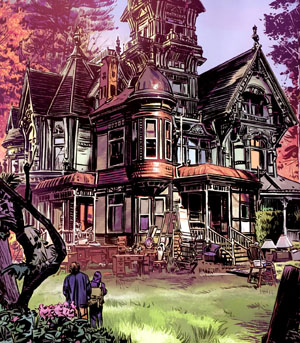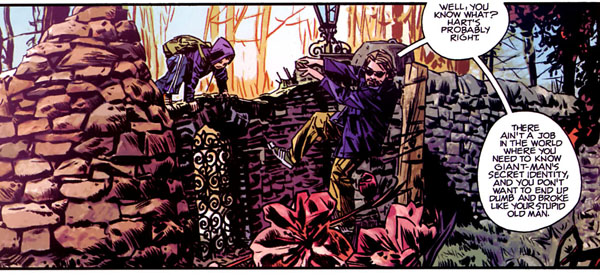 Written by Mark Millar
Written by Mark Millar
Art by Tommy Lee Edwards
32 pages, color
Published by Marvel Comics
Entering your favorite fictional world has got to be one of the top five daydreams of young kids. Books, comics, movies, television shows, you name the media, someone’s imagined being able to interact with characters inside it. That’s what Mark Millar and Tommy Lee Edwards are tapping into with their Marvel 1985 mini-series, having a character from our world discover that characters from his favorite comics are now real and in his home town. But once you get past the initial hook, is there really anything new?
 Toby’s got a lot on his mind at the start of 1985. He’s still upset over his parents’ divorce, refusing to talk to his step-father whenever possible. He’s trying to fit in with his classmates, even though reading comics isn’t the cool thing to do. He can’t wait to get the new issue of Secret Wars. And so far as he can tell, a group of super-villains from the Marvel Universe have bought a house on the other side of the woods and are pretending it’s a new nursing home.
Toby’s got a lot on his mind at the start of 1985. He’s still upset over his parents’ divorce, refusing to talk to his step-father whenever possible. He’s trying to fit in with his classmates, even though reading comics isn’t the cool thing to do. He can’t wait to get the new issue of Secret Wars. And so far as he can tell, a group of super-villains from the Marvel Universe have bought a house on the other side of the woods and are pretending it’s a new nursing home.
The basic plot of Marvel 1985 #1 is, to be fair, a little unremarkable. It’s very predictable and traditional and feels almost like it’s been created off a checklist; troubled family life, well-meaning father, caustic mother who doesn’t appreciate the father, kid discovering the Marvel super-villains in the creepy old house in the forest. It could be that this is all very deliberate and Millar’s playing with story archetypes, it could be that this is just a very traditional and standard story. Where Millar does excel, though, is how he writes Toby. Despite the generic trappings he’s saddled with, Toby comes across very real, with that strange combination of childlike innocence and the uncomfortable, awkwardness that arrives as you enter your teen years. Somehow, it makes everything else more palatable, the clichés not coming across as flat as they’d feel otherwise.
Edwards is the kind of artist who can walk the line between real-world and super-hero art quite adeptly, and that makes him a smart choice for Marvel 1985. He’s able to make Toby and his world look very recognizably like ours, with realistic looking people and settings everywhere. At the same time, though, he’s able to draw super-villains in that same style without making them look ludicrous or out-of-place. It’s a smart looking book, one where I could cheerfully look at 32 pages of Edwards drawing characters walking through woods every month. Everything’s richly detailed, from trees and birds to comics on the walls of the local store and each wooden plank on the old house in the woods.

Marvel 1985 #1 has a few weak points, but for now it manages to compensate with them thanks to a level of exuberance that overwhelms the potential problems. With five more issues to go, hopefully the later installments will smooth out the rough edges. For now, though, I’m certainly entertained enough to want to read what happens next. And that, after all, is exactly what a first issue should do.
